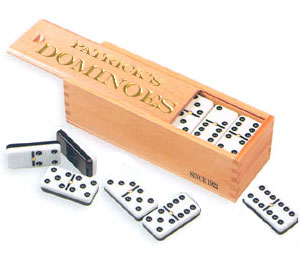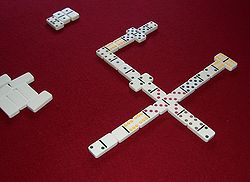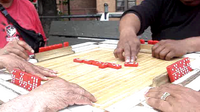From The Peopling of New York City
Contents |
Dominoes
Historical Background
The first set of Dominoes dates as far back as 1120 A.D. Dominoes, which originated in China, actually descended from the cubic dice, which was introduced to China from India. Dominoes were constructed to be all possible numbers resulting from throwing a pair of dice, with each half of the Domino representing a die. Chinese Dominoes only consisted of the 21 results from throwing a die numbered from one to six. In the Chinese set, there are duplicates of pieces that are divided into what is called the "Civil and Military" ranks. In the 18th century, the board game made its way to Italy and then spread throughout Europe. In Italy, the board game was slightly modified; rather than having duplicates, the European version had only one set. An additional seven dominoes were added to the set, containing on one half of the domino a number from 1-6 and on the other half, its blank counterpart, as well as a domino that was blank on both halves.
The name "Domino" derives from the Latin word, dominus, a mask worn in Venetian Carnivals that were white with black dots, resembling the Dominoes. The masks were actually named because they resembled the winter hoods that French Priests wore, which were black on the outside and white on the inside.
How to Play Dominoes
The objective of the game of Dominoes is to be the first to empty your hand of the game pieces, while simultaneously blocking your opponents' throughout the game. In the beginning, all of the pieces are laid face down, so that the side with the pips (black dots) is not seen. Someone shuffles and scatters the Dominoes. Each player takes seven pieces and the remainder become the "stock or boneyard" where players will obtain pieces in case they do not any other dominoes to put down. After this the game officially starts. The person who has the highest or "heaviest" piece goes first. The heaviest Domino piece is called this way because of its value, which is the double six. If no one has the double six, the next highest Domino is put down.
This Domino commences the line of play, which is the arrangement of tile pieces on the table. Each half of a Domino in the players' hands can then be matched to one of the halves put down on the table. Dominoes can only be added to the ends of this line of play. Sometimes the line is turned into a right angle if the Dominoes get too close to the edge of the table.
The line of play grows in opposite directions as the game progresses. In some versions of the game, the doubles are called and serve as spinners, which means they can be played on all four sides of the dice. The game continues until one of the players has put down all of their tiles and wins the hand, or until the game is blocked and no other pieces can be put down. This occurs when the entire set of one number has been put down on the table and the end pieces contain this number. Because all of them are on the table, the game cannot continue. This, of course, only happens when there are no pieces left in the boneyard in which the "match" can be found.
Scoring differs depending on the way the game ends. If the game is finished naturally, where the game is not blocked, the person who wins counts up all of the pips on all the other players' pieces. This number is their score. If the game is blocked, the person who has the lowest amount of pips wins. In some versions of the game, the person who blocks the game gets to see who has the highest number of pips and this becomes their score. Therefore, it can be either disadvantageous or advantageous for a player to block the game depending on how many pieces their opponent has.
Demographics
Dominoes is played all around the world. Its prevalence, however, lies within Latin American culture. When immigrants from Latin American countries bring over their traditions from their native countries, they also bring their box of Dominoes along with them. In New York City, immigrants from Puerto Rico, Dominican Republic as well as Cuba, continue the Domino tradition. These Hispanic groups are most likely to be found playing Dominoes outdoors within sectors of the Bronx and Manhattan in predominantly Spanish neighborhoods such as Spanish Harlem and Washington Heights.
They can even be found playing in neighborhoods that are not predominantly Spanish. Puerto Ricans, Dominicans and Cubans consider Dominoes a fun,casual pastime. Dominoes is a way that Latinos bond with their friends, family, neighbors and even strangers. In playing dominoes with their compatriots, they connect to their home culture. They reminisce the earlier days in their home country, when instead of being surrounded by strangers, they were surrounded by their closest family members, playing in the open backyards of their tropical homes. Through Dominoes, these people are able to retain their cultural traditions. Some smoke cigars while playing, others drink a few beers. When they're not deep in concentration, they speak Spanish to each other, either celebrating their victories or bickering at each other for a lost round. While they play, salsa may be heard, underneath the sirens and whizzing cars of the city metropolis around them.
In Latin America, the flourishing of Dominoes goes hand in hand with the levels of poverty in each Latin American country. Because the poverty levels are so high, Dominoes becomes a common pastime for those with no job or those who cannot afford more expensive forms of entertainment. Rather than going to the movies or out to a fancy restaurant, many Latin Americans simply turn to their kitchen tables and a box of Dominoes for a good time. Many times, these same people play the game for money, hoping to earn something for their skill and expertise. Some even join tournaments around the country. To these poverty stricken natives, playing Dominoes is an escape from the world into a game where they can immerse themselves in deep concentration while demonstrating the skill they have learned from their predecessors.
Dominoes in New York City
The Latin American immigrants in New York City play Dominoes for no different a reason. Although they may be much better off than the poor in their native countries, the hispanics of NYC still hold the same sentiments. They too, face struggles in everyday life and seek an escape from their worries. They play Dominoes because they have no other hobbies or they cannot afford more expensive forms of entertainment. The men interviewed in the following video are either of Puerto Rican or Dominican descent. This small triangular park, located in the northwest part of the Bronx, Kingsbridge, is where they go every single day to play the game of Dominoes. Many times, says one, they stay there until 2 am.
Dominicans and Dominoes: A Personal Experience
My family is an immigrant family; we have all come from the Dominican Republic, save for the second generations, who are American-born citizens. Although much of my family speaks English and is familiar with the American culture, the members of my family have not lost their identity as Dominicans in the least bit. At home, my family and I speak Spanish, watch Spanish channels predominantly, and listen to Spanish music throughout the house. And, then, of course, there are the delicacies of Dominican food, which are put on the dinner table almost every day. Although we may sometimes enjoy eating foods from other cultures or just more gourmet food, our taste buds seem to always yearn to taste the food of "Quisquella". The younger generation, American born, learns everything about their culture through their parents and other family members. Many times, we take trips to the Dominican Republic to visit family and see the country for ourselves. Therefore, the younger generation is exposed to the traditions, learning about the country and its customs, reinforcing these traditions while with the family and finally strengthening the bond to roots of these traditions by going to the native country and experiencing the true culture first-hand. One of the many traditions learned throughout the second generation's lives, is of course, the board game of Dominoes- considered a national sport of the Dominican Republic.
As a Dominican New Yorker, Dominoes is a game that is very much part of my culture. It is usually played at gatherings, whether it's a barbecue, in a backyard, by the pool, in a park, or even at home. Adults usually play the game more than children do, since Dominoes requires quite a lot of strategy and diligence in order to know how to keep track of the Domino pieces and be successful at the game. When children play, they are not taken very seriously unless they actually have acquired the counting skill, which is a rare case. The adults use Dominoes as a pastime, something as common and very parallel to watching a football game in the United States. Men are able to unite with their friends, compatriots and family members, engrossing in conversation as the game progresses. In general, more men than women play the game, although in my family, women dominate the game just as well and sometimes even more so than men.
I learned to play Dominoes as a child, from my parents and aunts; playing Dominoes gives us, as a family, a chance to bond. Children delight in seeing a younger, more competitive and joyful side to their seemingly lame parents. Dominoes is a big deal and becomes very eventful whenever it is played. Excitement arises as everyone gathers around to see who will dominate the game. We joke around, laugh and just have a great time playing a game that not only unites us a family, but unites us as a culture as well. The bonds that we strengthen whilst playing Dominoes, whether with each other or with our treasured Dominican culture, are innumerable.




